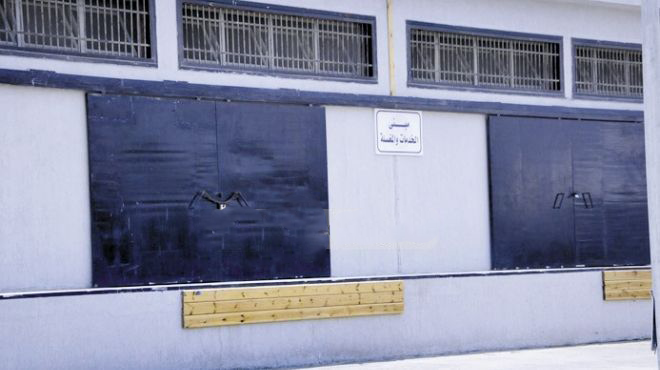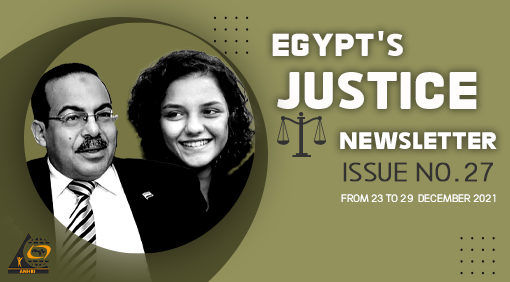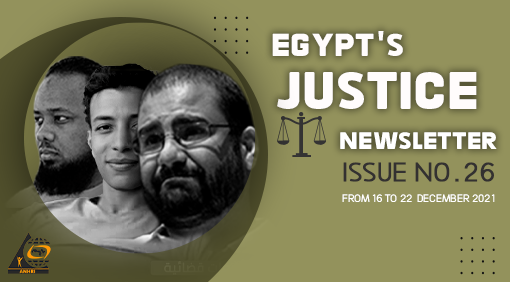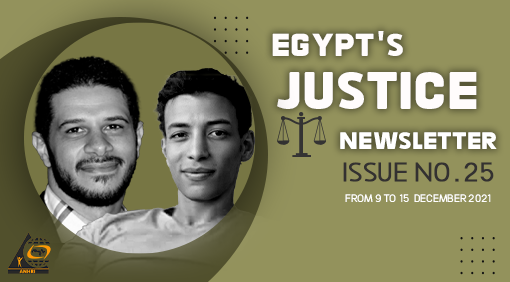
Prison’s location
The May 15 Prison is a central prison affiliated with Cairo Security Directorate and is located at the end of Autostrad Road, before Al-Kuraimat Road in the area of May 15 City, south of Cairo. The prison was established pursuant to the Interior Minister Resolution No. 1030 of 2015, published in the Egyptian Gazette (issue No. 118). The decision came as a result of the increase in the number of defendants and detainees in Cairo’s police stations and in order to relieve the massive overcrowding in prisons and detention centers. The Ministry of the Interior assigned the Egyptian Arab Contractors Company- headed by Eng. Ibrahim Mahlab before he assumed the Prime Minister’s Office- to carry out the establishment of the prison.
Its establishment
Inaugurated on 4 June 2015, it took only 8 months to build the May 15 Prison at an estimated cost of 160 million Egyptian pounds. Its inauguration was accompanied by a tremendous media storm with the participation of a group of human rights activists who are close to the authorities and security apparatuses, and contributed to presenting the prison to the public as a model prison that serves as an achievement accomplished by the Interior Ministry.
Established on 12 acres of land, the prison consists of wards, administration buildings, clinic, visitation rooms, services, laundry, kitchen, wire fences, camp, guard towers and gates. The prison buildings are provided with a firefighting system, medium pressure valves, transformers, cables, distribution panels, lighting, telephone cables, alarms and others.
There are 8 wards in the prison; each of them is divided into a number of cells. The prison can hold up to 4,000 inmates which is unusual in central prisons that used to have a capacity of up to a few hundred prisoners. (1)
The prison includes those who are convicted and sentenced to a period up to three months as well as those held in pretrial detention for a period exceeding 4 days, noting that the number of detainees at the time of its inauguration was actually about 3,020.
For the first time in prisons, some halls in May 15 Prison were dedicated to public prosecutors, judicial bodies and lawyers, which makes it possible to renew the detention of pretrial detainees without having to transfer them for each hearing, despite the fact that an official decision by the Minister of Justice is necessary for each investigation or hearing that is set to be convened in a prison instead of a court.
The new May 15 Prison is known for its negligence and abuse of detainees and not having a lounge for visitors, in addition to the abuse of power; as some security personnel used to trade off illegal prescription drugs and pills. Recently, a low-ranking police in charge of inspecting and introducing visits to prisoners has already been arrested while smuggling narcotic pills and drugs (cannabis/ Hashish and Banjo) into jails, and during his investigation, he committed suicide by throwing himself from the fourth floor felling to his death.
Testimonies on violations against detainees
One of the most famous documented testimonies of the detainees held in May 15 Prison is one given by Ahmed Mohamed Hassan, aka “Istakoza”, after his release on bail on August 3, 2016. Both Ahmed Hassan and Dr. Taher Mukhtar were arrested from their houses in January 2016 on the fifth anniversary of the January 25 Revolution, before they were referred to the Public Prosecution on charges of “possessing publications aimed at overthrowing the regime and changing the principles of the constitution”. (2)
In his testimony, Istakoza said:
“20 January 2016 will remain one of the worst and most gloomy days to me, if not the worst one. Every single minute in this day is engraved in my memory with all its details, no matter how much I try to forget it. I was held in Abdeen Police Station’s custody, and on that day the president of China was visiting Egypt and al-Sisi was welcoming him. The police station’s officials then decided to transfer me, along with a group of criminals, to May 15 Prison as part of the security measures carried out at the time.
This deportation/transfer was the worst and most ridiculous one I have ever experienced since I got detained. Although we had a lot of trouble, this deportation was very harsh; we spent more than 10 hours in the patrol/deportation car and we were 28 persons holding their own staff and belongings (bags and bed covers). This is because the deportation officer was begging the prison to take us as the police center’s officers were probably afraid of us.
When we got out of the deportation car, they started to beat a good old man named “Am Adel” who was one of the detainees held at Abdeen police station. They punched him through the back, which made the man shouted at them. Consequently, the prison’s officers and detectives hit him hard, dragged him to the ground and literally squashed his face with their feet. The beating was so brutal that the deportation officer who came with us from the Abdeen station objected to it, before a prison investigation officer told him: ‘What brought you here with your weapon? Get out of here”. They kicked him out and continued to beat “Am Adel”.
Thereafter, we met a short man wearing civilian clothes (we later learned that he is the prison’s chief of detectives) coming to us in fast and confident steps saying “What’s up” and when they told him, he said “Move away”. We thought for a few moments he would save the man from their brutality, but he jumped on his face at full force before he sprayed pepper balls into his eyes and face which was full of blood to the extent that we thought his eyes were poured out. Thereafter, he turned his face and told us- in a manner of speaking similar to that of thugs appearing in cinema movies: “Does anyone here need something?”
In the meantime, we were all staring at the ground as they ordered us to do so. Anyone who tries to object to the matter, the assault will be turning to him. This was really one of the most moments where I felt I’m powerless and helpless throughout my whole life“.
In a testimony about his detention in May 15 Prison in late 2015, Dr. Ahmed Said wrote: (3)
“On the night of my sentencing hearing, I was transferred with three of my co-defendants from Abdeen police station to May 15 Prison. The welcome parade, which we expected, was about to start before we hear the chief detective from afar telling them to stop. Getting out of the deportation car, the four of us were pushed across the prison gate while subjecting to a torrent of abuse and verbal insults ordering us to run and look at the ground and to sit cross-legged on the floor. Afterwards, the chief of detectives came to us along with the prison’s superintendent and doctor.
The superintendent asked “Who is Ahmed Mohamed Said Fathi Ghanem?”, I replied “It’s me”. He asked me whether I’m the doctor who came from Germany. I said yes. Then he asked me about my mother’s full name and I told him.
They ordered us to completely take off our clothes in what was supposed to be a medical examination, as the doctor asked us if we suffer from chronic diseases, and my co-defendant said that he suffers from a chronic lung disease.
They ordered us all to bend forward so that a detective or a low-ranking police officer do an anal medical examination for us one by one, and when I refused, a number of detectives and police officers handcuffed me and I was sexually assaulted like my colleagues.
Then we were put in a disciplinary cell although we hadn’t been officially registered. Our detention in May 15 Prison lasted approximately 18 days, during which I announced entering a hunger strike and I lost my feeling of time days after.
During this time, I explicitly requested to file a communiqué reporting my hunger strike more than three times, but they were all ignored. The prison doctor visited me twice to convince me to stop going on strike, but I insisted.
Throughout my detention, my family and lawyers visited the prison and tried to make sure that I was there, but the prison administration denied my presence until the third time that they acknowledged my presence and allowed my family to visit me.
On the day of the visit, they officially registered our names and gave us “Miri” clothes, and made sure that none of the prison criminals approached us. I could not walk. Two of the prison officials carried me to the visitation room. It was a “cage visit”; I was standing in an iron cage a meter apart from another iron cage where my family stood. Before the visit, the chief of detectives had threatened me not to tell my family about my hunger strike.
The visit was under the supervision of the security forces. Were they affiliated to the investigating authority or the State Security? I don’t know.
Three men, including the chief of detectives, were standing with me in the same cage, and behind my family. I told my family about the strike and the visit lasted only ten minutes. The next day, the head of the Prisons Authority visited me in my cell and asked me if someone had offended or assaulted me in prison. He also asked me about the reason for my hunger strike, before he left. Shortly thereafter, the prison’s director summoned me to his office and tried to convince me to acknowledge- in writing- that I was not on hunger strike but rather I was suffering from depression and loss of appetite.
My brother had lodged a complaint with the Public Prosecutor’s office right after he left the prison the day he visited me. The prison’s director tried hard and used all the ways to convince me to deny all the aforementioned incidents until he resorted to threats and intimidation. All what I requested to break my hunger strike was to transfer me to “normal prison” where we can acquire the rights of prisoners guaranteed by the law and regulations. The prison’s director promised me to transfer all of us to Tora Prisons Complex if I ended the strike, and I insisted that my co-defendants be transferred first, which actually happened as we were all transferred on the same day to Tora Prisons Complex, but to the high-security prison II.”
========================
(Footnotes)
(1) The Egyptian Arab Contractors Company’s website, “The Interior Ministry inaugurates the May 15 Central Prison”, published on June 4, 2015, accessed on July 8, 2020
https://arabcont.com/Release-2015-988
(2) Al-Nadeem Center, Posted in 2019, accessed on 4 June 2020
https://elnadeem.org/wp-content/uploads/2019/03/Detainees-Testimonies-Jan-Feb-2019-AR.docx
(3) A testimony sent from Ahmed Said, former prisoner of conscience residing in Germany, in September 2020







